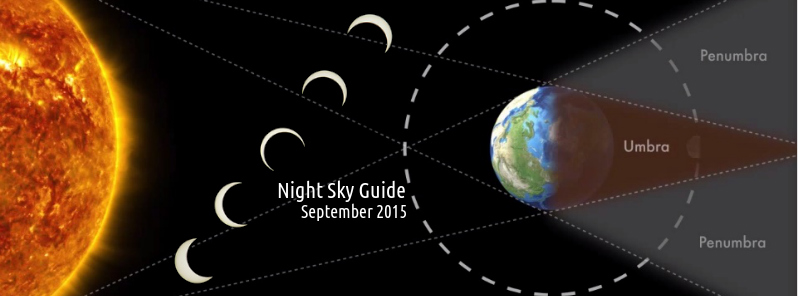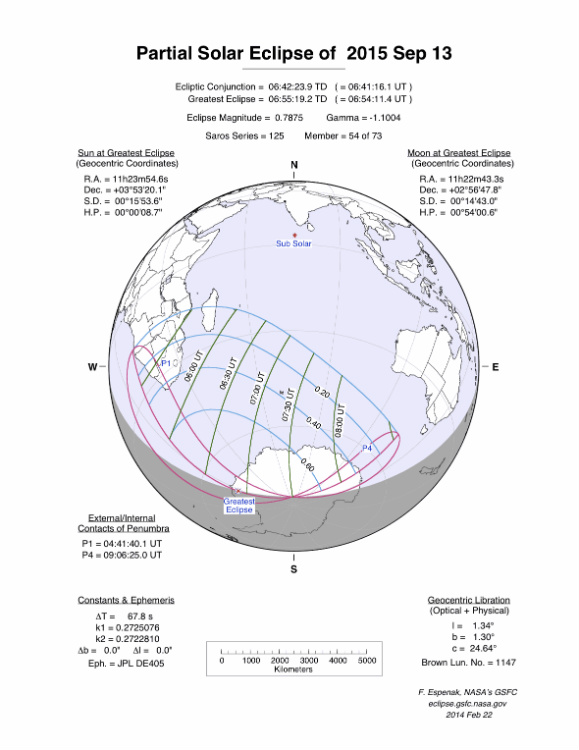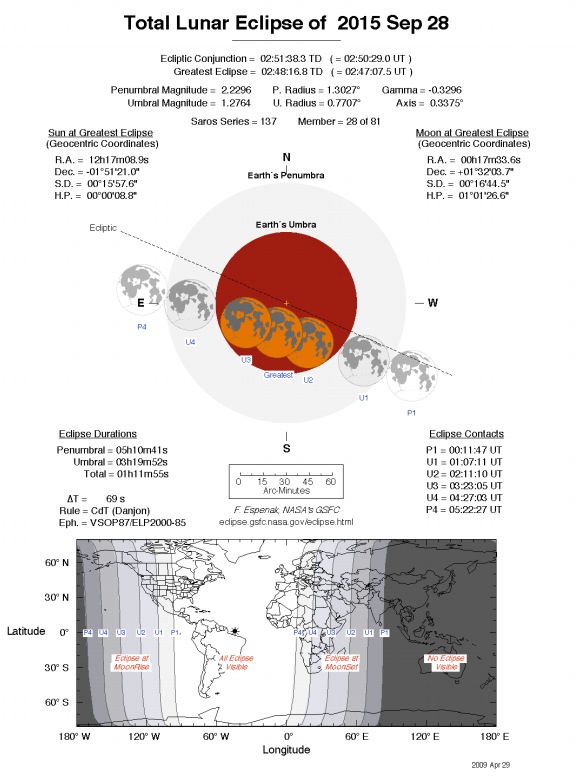Night sky guide for September 2015

This month hosts two very interesting celestial events. First, a partial solar eclipse on September 13, visible only in southern Africa, Madagascar and Antartica. The second, total lunar eclipse on September 28 and the closest supermoon of 2015. This full Moon is also called the Harvest Moon, in northern hemisphere, and the Blood Moon, because it ends the current lunar tetrad – series of 4 consecutive total eclipses occurring at approximately six month intervals. The totality will last 1 hour and 11 minutes.
September equinox occurs at 08:21 UTC on September 23. This day will mark the first day of fall (autumnal equinox) in the northern hemisphere and the first day of spring (vernal equinox) in the southern hemisphere.
The best time of the month to observe faint objects such as galaxies and star clusters is on September 13.
-
September 1 – Neptune at opposition. Neptune will be at its closest approach to Earth, its face will be fully illuminated by the Sun and visible all night long. It will be well placed for observation, in the constellation Aquarius, reaching its highest point in the sky at around midnight local time. Due to its extreme distance from Earth, it will only appear as a tiny blue dot in all but the most powerful telescopes.
-
September 1 – Conjunction between the Moon and Uranus. The Moon and Uranus will make a close approach, passing within 1°02' of each other. At the moment of closest approach, the Moon will be at mag -12.6, and Uranus at mag 5.7, both in the constellation Pisces. They will be too widely separated to fit within the field of view of a telescope, but will be visible to the naked eye or through a pair of binoculars.
-
September 4 – Mercury at greatest eastern elongation. The planet Mercury will reach greatest eastern elongation of 27 degrees from the Sun. This is the best time to observe it since it will be at its highest point above the horizon in the evening sky. Look for the planet low in the western sky just after sunset.
-
September 4 – Comet P/1999 R1 (SOHO) at perihelion. P/1999 R1 (SOHO) will make its closest approach to the Sun, at a distance of 0.05 AU. It is also expected to reach its brightest, at around mag -4.0, on the same day.
-
September 9 – Piscid meteor shower. The Piscid meteor shower will reach its maximum rate of activity on this day. However, some shooting stars associated with the shower are expected to be visible each night from September to October. The maximum rate of meteors expected to be visible from a dark location is around 10 per hour (ZHR). The Moon will be 26 days old at the time of peak activity, and so will present minimal interference.
-
September 13 – New Moon – 06:41 UTC. The Moon will be located on the same side of the Earth as the Sun and will not be visible in the night sky. This is the best time of the month to observe faint objects such as galaxies and star clusters because there is no moonlight to interfere.
-
September 13 – Partial solar eclipse. The instant of greatest eclipse takes place at 06:54 UTC. This is 1.2 days before the Moon reaches apogee. This partial eclipse will only be visible in southern Africa, Madagascar, and Antarctica.

-
September 19 – Conjunction between the Moon and Saturn. The Moon and Saturn will make a close approach, passing within 2°45' of each other. At the moment of closest approach, the Moon will be at mag -11.2, and Saturn at mag 1.1, both in the constellation Libra. They will be visible to the naked eye or through a pair of binoculars.
-
September 23 – September equinox – 08:21 UTC. The Sun will shine directly on the equator and there will be nearly equal amounts of day and night throughout the world. This is also the first day of fall (autumnal equinox) in the northern hemisphere and the first day of spring (vernal equinox) in the southern hemisphere.
-
September 23 – Comet 51P/Harrington reaches its brightest. 51P/Harrington is expected to reach its brightest, at around mag 12.4. It will lie at a distance of 1.74 AU from the Sun, and at a distance of 0.83 AU from the Earth.
-
September 25 – NGC 55 well placed for observation. A barred irregular galaxy in Sculptor – NGC 55 – will be well placed for observation across much of the world. It will reach its highest point in the sky at around midnight local time. At a declination of -39°10', it is easiest to see from the southern hemisphere and cannot be seen from latitudes much north of 30°N. At magnitude 8.0, NGC55 is quite faint, and certainly not visible to the naked eye, but can be viewed through a pair of binoculars or small telescope.
-
September 25 – C/2011 KP36 (Spacewatch) reaches its brightest. Comet C/2011 KP36 (Spacewatch) is forecast to reach its brightest, at around mag 12.8. It will lie at a distance of 5.19 AU from the Sun, and at a distance of 4.43 AU from the Earth.
-
September 27 – 47-Tuc well placed for observation. The second brightest globular cluster in the sky, 47 Tuc (NGC 104), in Tucana, will be well placed for observation across much of the world. It will reach its highest point in the sky at around midnight local time. At a declination of -72°04', it is easiest to see from the southern hemisphere and cannot be seen from latitudes much north of 2°S. At magnitude 4.0, 47-Tuc is tricky to make out with the naked eye except from a dark site, but is visible through a pair of binoculars or small telescope.
-
September 28 – Total lunar eclipse. This will be a total lunar eclipse and the closest supermoon of the year. September's full Moon is also known as the Harvest Moon, and Blood Moon, because it ends the current lunar tetrad – series of 4 consecutive total eclipses occurring at approximately six month intervals. The Moon will be totally eclipsed (totality) for 1 hour and 11 minutes, but the instant of greatest eclipse takes place at 02:47 UTC.
In the US, this is 22:47 EDT, 21:47 CDT, 19:47 PDT on September 27. In Europe, Middle East, Asia and Australia: 03:47 BST, 04:47 CET, 05:47 AST, 09:47 ICT, 12:47 AEST… on September 28.

-
September 29 – Conjunction between the Moon and Uranus. The Moon and Uranus will make a close approach, passing within 0°58' of each other. At the moment of closest approach, the Moon will be at mag -12.8, and Uranus at mag 5.7, both in the constellation Pisces. They will be visible to the naked eye or a through pair of binoculars.

Video credit Hubble Space Telescope
Sources: InTheSky (Dominic Ford), SeaSky
Featured image: background image by NASA, partial solar eclipse composition by Yisiris. Edit: The Watchers.

Commenting rules and guidelines
We value the thoughts and opinions of our readers and welcome healthy discussions on our website. In order to maintain a respectful and positive community, we ask that all commenters follow these rules:
We reserve the right to remove any comments that violate these rules. By commenting on our website, you agree to abide by these guidelines. Thank you for helping to create a positive and welcoming environment for all.